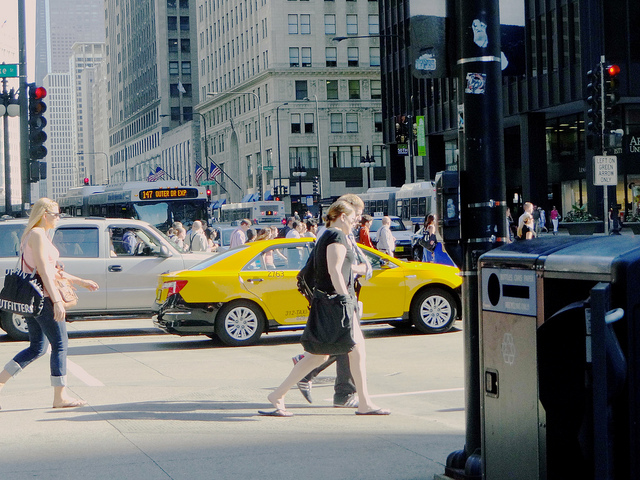Making Chicago a better place for women
By Leah Pickett
Pedestrians at Lake and Michigan. Flickr/Stephanie Valentina
1
/ 2

Pedestrians at Lake and Michigan. Flickr/Stephanie Valentina
1
/ 2
Making Chicago a better place for women
By Leah Pickett
WBEZ brings you fact-based news and information.
Sign up for our newsletters
to stay up to date on the stories that matter.

A recent article in The Atlantic‘s Cities section, “How to Design a City for Women,” described how officials in Vienna, Austria began taking gender into account in public policy, specifically in urban planning.
This process of “gender mainstreaming” began in the early 1990s, after administrators surveyed residents of the city’s ninth district and discovered that women were using public transportation more frequently than men, and for more varied reasons. Since then, over 60 pilot projects have been carried out to give men and women equal access to city resources.
The ultimate goal of Vienna’s gender mainstreaming project, which remains in effect today, is to ensure that all women are given the same opportunities to succeed in an urban environment as their male counterparts. According to Eva Kail, a gender expert in the city’s urban planning group, “It’s about bringing people into spaces where they didn’t exist before, or felt they had no right to exist.”
But would such a gender-specific plan work in a city like Chicago?
As a gender role-eschewing feminist with vivid memories of the “For Her” Bic Pen fiasco, I can see the criticism coming from a mile away. Shouldn’t we design a city for people, not men and women? Wouldn’t such a plan just reinforce steoreotypes of how men and women use public space? Or, to quote one frustrated Austrian opposed to the capitol’s exhibit of Who Owns Public Space, “Does this mean that we should paint the streets pink?”
To distance themselves from the idea that the project is about dividing people by gender, not bringing them together into spaces of equal opportunity, Viennese officials have begun to shy away from the term gender mainstreaming. Instead, they have opted for the label “Fair Shared City,” to reflect their goal of equality for all.
Obviously, Chicago is a drastically different city than Vienna. Also, certain discrepencies in lifestyle between Viennese men and women (for example, women using public transit more often and making more foot trips than men, mostly to run errands, take their children to school, and tend to their elders) do not directly align with the commutes of typical Chicago urbanites, many of whom are students or single and living independently.
Still, if Chicago officials did choose to implement a similar plan, what changes would we see?
Ideally, the city would showcase more art and installations by female designers, artists and architects. Perhaps we could also design parks and children’s spaces to be more gender-inclusive with a wider range of activities, or create more innovative housing to aid working mothers and families, like Vienna’s Women-Work-City.
Designing a city with women in mind is not about building more shopping malls, planting more flowers or erecting a bizarre Marilyn Monroe statue for tourist upskirt shots.
The key to understanding what women want is not rocket science: just ask. If city officials surveyed the women of Chicago, asking them about the struggles they face on a daily basis and what the city could do to better meet their needs, the answers might surprise them.
Leah Pickett is a pop culture writer and co-host of WBEZ’s Changing Channels, a podcast about the future of television. Follow Leah on Facebook, Twitter and Tumblr.
